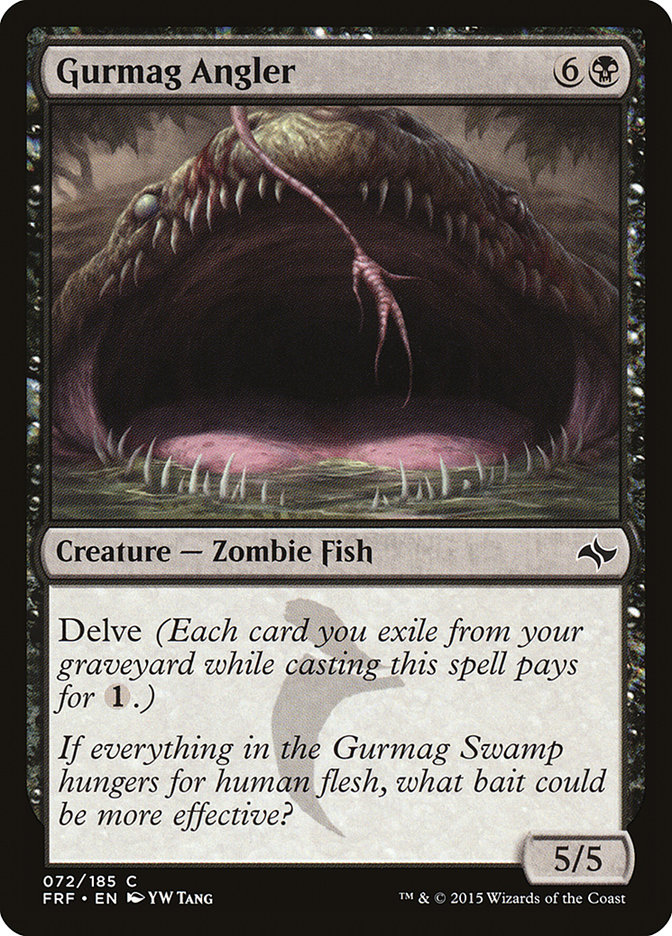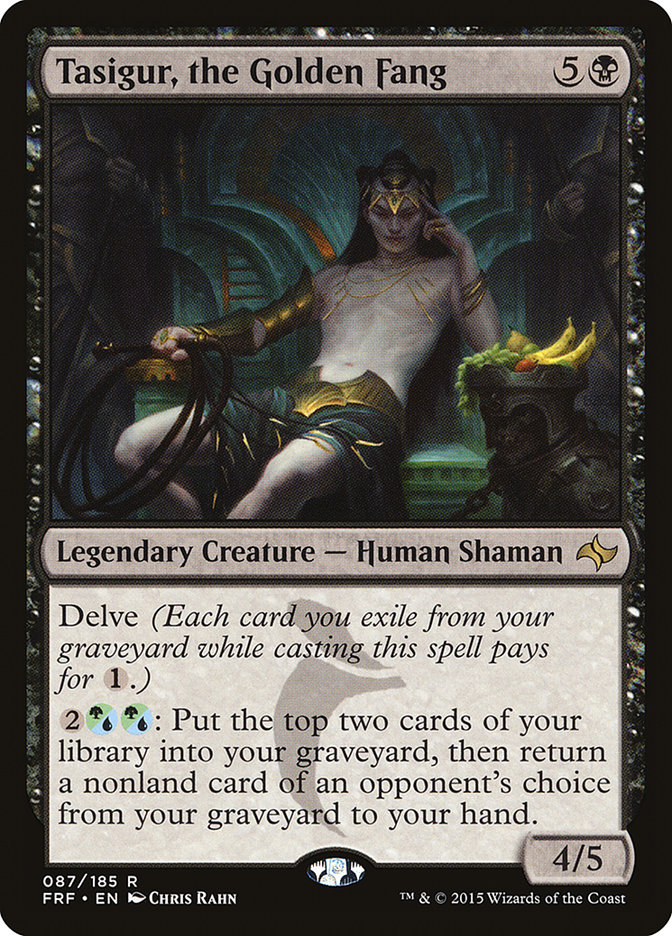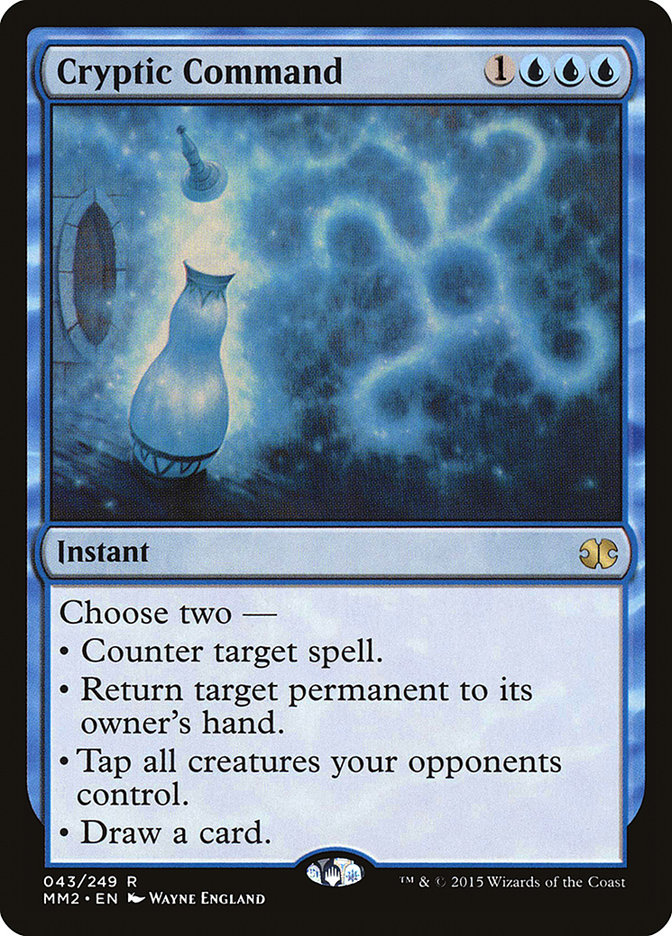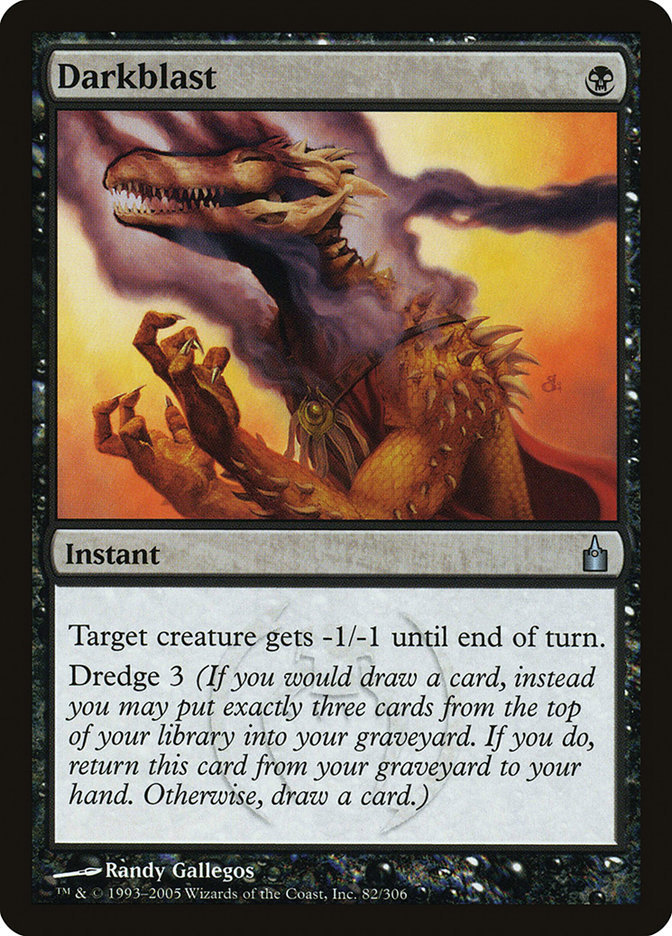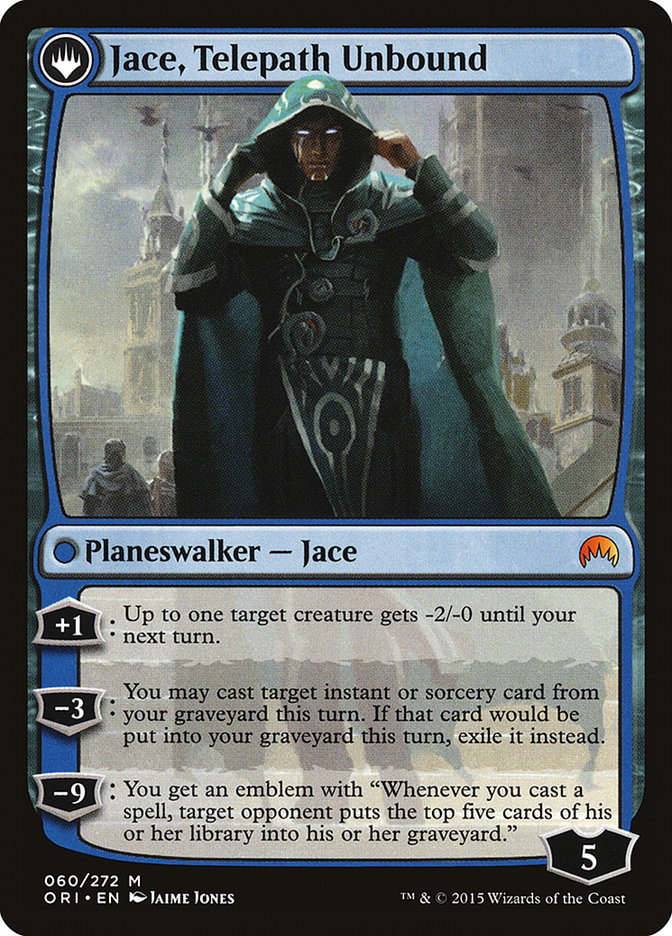If you’re trying to spike a Modern PPTQ, you’re probably looking at the various forms of Grixis decks either because you think it’s your best chance of winning or the deck that you’re going to have to go through it at least once in order to win the tournament. Thanks in part to Patrick Chapin ninth-place finish at Grand Prix Charlotte, Grixis is probably the best color combination in Modern.
Why Grixis?
In short, it’s because of this interaction:
Previously, decks like Jund could use discard to punch a hole through your defenses, allowing something like a Tarmogoyf or Liliana of the Veil to slip through the cracks. Any sort of U/R deck has a difficult time dealing with either of those, and while Snapcaster Mage and Kolaghan’s Command don’t deal with them directly, they give you consistency.
In those scenarios, their discard is less effective. If you look at a hand of Terminate, Lightning Bolt, Snapcaster Mage, and Kolaghan’s Command, you aren’t able to punch any holes. No matter what, the Grixis player is going to have access to whatever they want given enough time. There’s also the added bonus of being completely awesome against Affinity.
Of course, Kolaghan’s Command isn’t the only reason you should be concerned with your Grixis matchup.
Tarmogoyf used to be the king of Modern. It invalidated any creature deck that wasn’t trying to go wide because it was the king, but that’s no longer the case: Fate Reforged contained some nice Delve creatures for Modern. With cards like Treasure Cruise and Dig Through Time gone, Thought Scour is being used to cast these fatties ahead of schedule. They aren’t as good as the card drawers, but that doesn’t mean they aren’t the best thing you can be doing in Modern.
Since Jund no longer has an edge, Grixis can actually compete. So far, instead of simply competing, it’s taken over the format. When a color combination makes up one of the best decks, that’s nothing to get too excited about. However, when a color combination comprises most of the Tier One archetypes, then it becomes a big deal. Case in point: Abzan Control, Abzan Aggro, and Abzan Megamorph in Standard. Abzan is clearly the best color combination, it’s the most versatile, and it is the thing that people continually return to when trying to crack a stale Standard metagame. Grixis in Modern feels the same way.
And for as good as Abzan is in Standard, Grixis may be even better in Modern.
The Variants
There are currently three popular flavors of Grixis: Grixis Delver, Grixis Control, and Grixis Twin. Oddly enough, these three decks create a rock/paper/scissors metagame against themselves. Typically, Twin is good against Control, which is a good against Delver, which is good against Twin.
Grixis Delver
Admittedly, this is the archetype I have the least experience with. However, I do have several matches against the deck under my belt. The single thing that always stood out to me was how frequently they were drawing gas, and how amazed I was at how the “beatdown” deck out-carded me in the midgame. At first I thought it was a fluke, but after it happens enough times you come to realize that it’s probably just the way of things.
For starters, the Delver deck plays fewer lands than the other Grixis decks. Their curve is lower and they don’t have as many two-for-ones, but what they lack in those aspects they make up by having fewer lands in their decks. Grixis Control should have the edge in theory, but the games don’t always play out like that. It’s not uncommon for Grixis Delver to outdraw a string of Kolaghan’s Commands despite playing fewer copies of Snapcaster Mages and Kolaghan’s Command themselves.
Creatures (14)
Lands (18)
Spells (28)

Things to note:
- This deck operates from a very low base of resources. You are basically just trying to stick a threat and then trade one-for-one with your opponent. That allows the Delver deck to get under the other Grixis decks and actually have a good matchup against combo decks. Whereas Grixis Control might not stick a threat until turn three, Grixis Delver can get the party started on turn one.
- Since you’re more interested in trading one-for-one, this deck is more interested in playing Mana Leak than Remand. However, Remand is more useful in blue mirrors because you can Remand your own spells in counter wars, plus it’s typically better against a Snapcaster Mage. Cards like Spell Pierce are more appealing in this deck as well.
Grixis Control
If you were playing in a Modern tournament tomorrow, you could certainly do worse than copying Chapin’s ninth-place list from Grand Prix Charlotte. Since then, a few pieces of technology have come to light, so despite those decks not having a high-level tournament finish they are probably more tuned.
First of all, Cryptic Command is a clunker. While this deck is capable of playing a long game, largely in part due to Cryptic Command, and it happens to be a very good Cryptic Command deck, you can’t play too many of them. They clog your hand and you’ll find yourself using them on the first thing possible just to cycle them, which isn’t the optimal use of the card. Cryptic Command is clearly very powerful, but Modern is not a slow format. You can’t afford to play a bunch of four-mana spells regardless of what your deck is.
Another reason why Cryptic Command is somewhat of a liability is the mirror match. Maindeck Dispel is becoming increasingly more common, and losing your Cryptic Command to their one-mana counter is brutal. You can’t make trades like that and expect to win.
Darkblast is a maindeck inclusion that I’ve enjoyed immensely. Not only is it another Lightning Bolt in a lot of matchups, but it’s also a card that can be Dredged back, making Tasigur, the Golden Fang and Gurmag Angler very easy to cast. Sometimes you have a Thought Scour or two and it’s a non-issue, but I would happily play more Thought Scours if they’d let me plus Darkblast is perfectly serviceable on its own.
The mirror is a grindy affair that is ultimately skill-based, but in an even matchup it can come down to draws. Having additional sources of card advantage is a necessity, so I’ve stolen the LSV Mulldrifter technology. It’s a little slow, but it’s great with Kolaghan’s Command in longer games.
Here’s where I am currently:
Creatures (10)
Lands (22)
Spells (28)
- 4 Lightning Bolt
- 2 Mana Leak
- 4 Serum Visions
- 3 Terminate
- 1 Darkblast
- 1 Remand
- 2 Spell Snare
- 2 Cryptic Command
- 1 Dispel
- 1 Go for the Throat
- 4 Thought Scour
- 3 Kolaghan's Command
Sideboard

Things to note:
- Grixis Control is a dog to all forms of Splinter Twin. Sometimes they’ll take the combo out, but that’s ill-advised because they should be focusing on what they’re good at which is getting you dead. My sideboard does a very good job in shoring up that matchup with Duress, Spellskite, and Rending Volley.
- Magus of the Moon is much better than Blood Moon against decks like Amulet Bloom and G/R Tron. They will often expect Blood Moon and will sideboard around that, but they will likely not have any answers to Magus of the Moon after sideboard. You can try to grind them out with Fulminator Mages, but there’s no real point to that.
- Leyline of the Void is not realistically beatable in the mirror. There are some things like Keranos, God of Storms, Grave Titan, or Vendilion Clique they can board in that might help them, but you should be able to defeat those cards. With a Leyline of the Void in play, they can’t come close to matching your card advantage since most of it works off of your graveyard, plus they likely won’t be able to cast their delve fatties. If you expect mirror matches, Leyline of the Void is the card you want.
Grixis Twin
This is the deck that I would play if I had a Modern tournament tomorrow. My list is largely inspired from Kyle Boggemes list from the Season Two Invitational. I started making my own lists but slowly came around to similar ideas that Kyle had. The black splash didn’t seem to be doing enough to warrant it outside of Terminate, although Roast is a fine substitute, so I wanted to explore the idea of some early discard. Not only does it give you a different axis to attack combo decks on, but it’s something that is more proactive than attempting to sit on a Spell Snare the entire game.
Creatures (12)
Lands (23)
Spells (25)

Things to note:
- My first Grixis Twin lists only had seven combo pieces, but I didn’t like it. The idea is that the Splinter Twin combo gives you an advantage against the decks that you can’t naturally control, such as Merfolk, Burn, G/W Hexproof, G/R Tron, and Amulet Bloom.
- Keranos, God of Storms is my sideboard finisher of choice. I fully expect people to adapt with Dromoka’s Command, Unravel the Aether, and/or Celestial Purge, but that hasn’t quite happened yet.
- Spell Snare and Inquisition of Kozilek (or any situational counter) occupy the same deck space and largely attempt to solve the same issues. It’s possible that they don’t belong in the same deck at all. Spell Snare just so happens to be a much cleaner answer to Snapcaster Mage, and with Grixis variants being so popular I can’t imagine giving up entirely on Spell Snare.
How Many Snapcaster Mages Is Too Many?
Perhaps you’ve seen this card.
I’m unsure how well this card stacks up in Modern. On the one hand it’s a Looter, which fuels Delve, it is another pseudo-Snapcaster Mage, and it is a permanent that is difficult to deal with once it has transformed. On the other hand, Lightning Bolt exists and most Grixis decks are naturally well-insulated against Lightning Bolt.
The allure of Snapcaster Mage is that you get to do things at instant speed. If they don’t do anything, you can Snapcaster Mage a Lightning Bolt and get a clock going. If they cast something threatening, you can counter it. That flexibility is what makes Snapcaster Mage so busted, and Jace, Telepath Unbound only offers you a small piece of this.
On the other hand, permanents that do a lot of things for very cheap tend to be very good in non-rotating formats. The key example is Deathrite Shaman, a card that barely did anything in Standard. Jace, Vryn’s Prodigy isn’t quite the same, as it’s likely going to tear up the Pro Tour this weekend, but Deathrite Shaman likely would have done the same had fetchlands been around then so it’s all about context.
In this case, Jace, Vryn’s Prodigy does a lot of stuff that Grixis decks want to be doing in Modern, and if the only strike against it is Lightning Bolt I think that it’s still worth exploring.
Going Forward
Grixis is one of the best decks in Modern, if not the best deck. I group them all together because which version you decide to play largely depends on your metagame and what you’re hoping to defeat. Past that, I can’t give any rock-solid recommendations as to which is the best version because the answer depends on a number of factors. I would personally play Grixis Twin because I want a combo finish in my Modern deck. Attempting to grind out decks like Burn and G/W Hexproof is not viable, nor is it something I want to pursue. Instead, I’ll settle for setting up the one-two knockout punch.
Grixis Delver can fight those decks by racing them, and while Grixis Control is better against a lot of things, namely Jund, it struggles with the lesser-played decks in the format. Instead of preparing for the randomness, I want a deck that is naturally good against such things, and the Splinter Twin combo provides that. Jace, Vryn’s Prodigy could alter the paradigm a bit, but ultimately I think Grixis Twin will remain my favorite.




